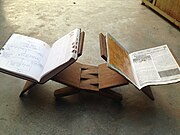Rehal (book rest)
Appearance
This article needs additional citations for verification. (February 2020) |

A rehalQur'an in Islam, the Ramayana in Hinduism, the Japji Sahib in Sikhism, and the Bible in Christianity) by keeping them elevated off the floor.[2]
Etymology
The name "rehal" ultimately derives from the Arabic word rahl (رَحْل) meaning "camel saddle", referring to the resemblance of the unfolded lectern to a saddle.[3] The word has been borrowed into other languages, such as Hindi-Urdu and Bengali.[1]
History
For centuries folding lecterns have served throughout the
Islamic world as supports for large Qur’an books used during recitations. They were among the most valuable furnishings of every mosque and were decorated using a variety of techniques, including calligraphy and abstract floral arabesque motifs. Secondary literature maintains that the form of these lecterns had been derived from folding chairs such as those that had already been used in ancient Egypt.[4] Certain English-speaking Muslims refer to the rehal as a "Qur'an stand". Among Christians, especially those living in the Indian subcontinent and in the Middle East, the rehal is used to hold the Bible, having a prominent position on church communion tables, as well as on home altars; in English, these are known as Bible stands, though these can be foldable or fixed at an acute angle.[5][6]
Gallery
-
Qur'anand rehal
-
Depiction of a rehal, with the Ramayana placed on it
-
The Bible placed on a rihal engraved with a Jerusalem cross
-
An unusual double rehal, in this case used for studying
See also
Notes
- as rahla or rahil.
References
- ^ ISBN 978-81-7182-297-3.
- ^ ISBN 978-1-63087-885-6.
In this case, the use of the rehal connects with the sense of how "God's word" should be reverently treated.
- Ethnographic Museum of Krakow. Archived from the originalon 24 January 2021.
- ^ "Qur'an stand | Discover Islamic Art | Virtual Museum". islamicart.museumwnf.org. Museum with No Frontiers. Archived from the original on 25 July 2021.
- ISBN 978-0-87808-993-2.
- ^ Turnbull, A. (1890). A Darjeeling Holiday. The Church of Scotland Home and Foreign Mission Record. p. 554.
Wikimedia Commons has media related to Bookstands.





